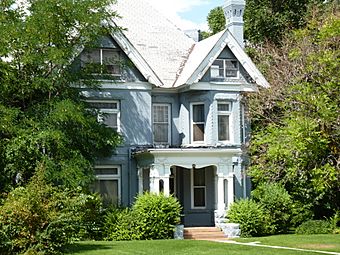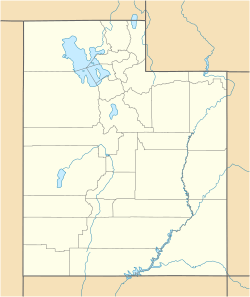Dr. Samuel H. Allen House and Carriage House facts for kids
Quick facts for kids |
|
|
Dr. Samuel H. Allen House and Carriage House
|
|

Samuel H. Allen Home
|
|
| Location | 135 E. 200 North Provo, Utah |
|---|---|
| Area | less than one acre |
| Built | 1897 |
| Architectural style | Late 19th and 20th Century Revivals, Queen Anne |
| NRHP reference No. | 79002515 |
| Added to NRHP | May 18, 1979 |
The Samuel H. Allen Home is a special old house in Provo, Utah. It's located at 135 E. 200 North. This house is so important that it's listed on the National Register of Historic Places. This means it's recognized as a significant historical building in the United States. It was built in 1897 and shows a mix of popular styles from that time.
Contents
What the House Looks Like
The Samuel H. Allen Home is a great example of how architecture changed around the year 1900. It mixes the fancy Queen Anne style with newer "revival" styles. These newer styles focused more on balanced shapes and classic details.
Unique Features of the House
The front porch has classic details, but it also has wide, curved supports. This house is one of the tallest and largest historic homes in Provo. It even has a huge two-story building for carriages, which might be the biggest of its kind.
The house has four main parts that stick out, each with a pointed roof. It features rough stone above the windows and doors. You can also see decorative porch railings and fancy trim boards. The house uses different colors and has both square and angled bay windows. It's in good shape and hasn't been changed much over the years.
The Carriage House
The carriage house, where horse-drawn carriages were kept, is also very important. It has a special roof shape called a "monitor-form." The lower parts of its walls have been filled in with windows.
Provo's Grand Victorian Mansions
Between 1893 and 1908, many grand Victorian mansions were built in Provo, Utah. These homes are historically important. They show off beautiful architecture and belonged to some of the most successful men in the city and state at that time.
Famous Homes in Provo
Some of these famous mansions include:
- The Charles E. Loose House
- The William H. Ray House
- The Knight-Allen House
- The John R. Twelves House
- The Jesse Knight House
- The Knight-Mangum House
- The Thomas N. Taylor House
These homes show off many different fancy architectural styles. These include Eastlake, Shingle, Craftsman, Italianate, Classical, Moorish, Colonial, and Romanesque Revivals. Most of them are made of brick. They feature some of the finest and most detailed architecture you can find in Provo.
History of the Allen Home
Dr. Samuel H. Allen moved to Provo in 1892. He built his beautiful home using local workers and materials. For a few years, he also had his medical office right in his house. Later, he moved his office to another building in town.
Samuel R. Thurman's Time
In 1903, Samuel R. Thurman bought the home from Dr. Allen. Mr. Thurman had been the mayor of Lehi before moving to Provo in 1882.
In 1882, he became the youngest member of the Utah House of Representatives. He was elected to this position many times. Thurman was also involved in creating the Utah Constitutional Convention in 1882. He helped write the first part of the Provo People's Party's rules. As national political parties became more popular, Thurman became a Democrat. He also served as a judge on the Supreme Court of Utah.
John W. Taylor's Ownership
It wasn't long before Thurman sold the home to John W. Taylor. John W. Taylor was the son of John Taylor, who was the third president of the LDS Church. John W. Taylor used the income from four farms he owned in the area. In 1915, his financial situation changed, and he had to sell the house.
Dr. David Westwood and Later Owners
Taylor sold this house to Dr. David Westwood. Dr. Westwood became the vice-president of the Provo General Hospital, which was Provo's very first hospital. He used part of the home as his medical office. Later, his son, John T., who was a dentist, also lived in the home with his family. They even shared an office nearby.
During the 1940s, the Westwood family moved away, and the house was empty for a while. In 1952, Monroe and Shirley Paxman bought the home. They have lived there ever since. The Samuel H. Allen House was officially named a historic Provo City landmark on April 28, 1995. Both the house and the carriage house are recognized as important historical buildings.



